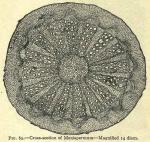158. Menispermum.—Yellow parilla.
 158. MENISPERMUM—YELLOW PARILLA.—The dry rhizome and roots of Menisper'mum canaden'se Linné. Rhizome about 1,000 mm. (40 in.) or more long, and 6 mm. (1/4 in.) thick; externally dark yellowish-brown, knotty, and longitudinally wrinkled; fracture woody and tough; nearly inodorous; taste bitter. Rootlets thin, brittle, yellow. A cross-section of the rhizome displays a thick bark and a yellowish interior. Under the microscope are seen numerous wood-wedges separated by narrow medullary rays; at the extremity of each wood-ray there appears a semilunar bundle, which on longitudinal section proves to be composed of bast fibers penetrating the bark. The diameter of the pith varies, not infrequently occupying one-third of the space between the bark. The overground stem, with which the drug is not infrequently mixed, has a very large, porous pith. Constituents: Berberine (yellow) in small amount, and menispine (white), the principal constituents, with resin, tannin, and starch. Alterative, tonic, diuretic, and laxative; said to resemble sarsaparilla in its action. The root was introduced into the market as Texas sarsaparilla. Dose: 5 to 30 gr. (0.3 to 2 Gm.).
158. MENISPERMUM—YELLOW PARILLA.—The dry rhizome and roots of Menisper'mum canaden'se Linné. Rhizome about 1,000 mm. (40 in.) or more long, and 6 mm. (1/4 in.) thick; externally dark yellowish-brown, knotty, and longitudinally wrinkled; fracture woody and tough; nearly inodorous; taste bitter. Rootlets thin, brittle, yellow. A cross-section of the rhizome displays a thick bark and a yellowish interior. Under the microscope are seen numerous wood-wedges separated by narrow medullary rays; at the extremity of each wood-ray there appears a semilunar bundle, which on longitudinal section proves to be composed of bast fibers penetrating the bark. The diameter of the pith varies, not infrequently occupying one-third of the space between the bark. The overground stem, with which the drug is not infrequently mixed, has a very large, porous pith. Constituents: Berberine (yellow) in small amount, and menispine (white), the principal constituents, with resin, tannin, and starch. Alterative, tonic, diuretic, and laxative; said to resemble sarsaparilla in its action. The root was introduced into the market as Texas sarsaparilla. Dose: 5 to 30 gr. (0.3 to 2 Gm.).

